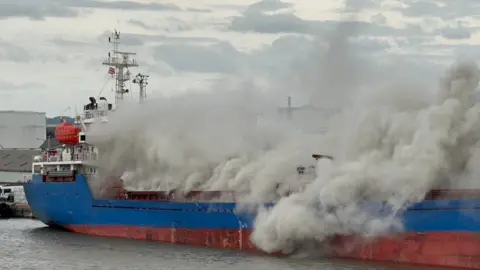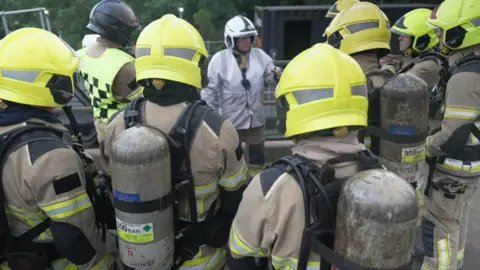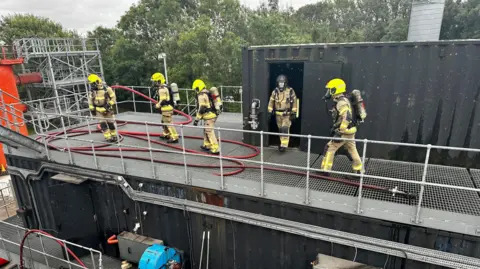
Senior Broadcast Journalist
 BBC
BBCFires at sea are rare, but when they happen, they can be deadly, with one fire trainer explaining, “effectively, we’re in a big metal box.”
Following a blaze in the cargo hold of a ship at Albert Dock in Hull, crews are continuing to train for one of the most dangerous jobs in the service.
BBC News was invited to Immingham to see how Humberside Fire and Rescue prepare for fires on board vessels.
On 27 June, crews were called to Albert Dock in Hull after a blaze broke out in a cargo hold packed with scrap metal leaving a thick plume of smoke drifting for miles over the city.
Just months earlier, in March, a man went missing, presumed dead after two ships collided in the North Sea off the coast near Withernsea.
A reminder of how serious maritime incidents in the region can be.
The risk is a real one and in Immingham, firefighters are put through intense, ship-based training to make sure they’re ready.

The facility in North East Lincolnshire is built from three stacked shipping containers and designed to replicate the interior of a real vessel.
It includes an imitation engine room, kitchen, crew quarters, and watertight doors and hatches made of thick heavy metal.
Trainer Gary O’Hara said: “Effectively, we’re inside a big metal box. All that metal’s getting superheated.
“If we put too much water in there, you potentially create a lot of steam.

Mr O’Hara said: “There isn’t any visibility, depending on what’s on fire. It could be thick, black, acrid smoke, so everything’s done by touch and feel.”
He said the scale of the environment made firefighting at sea unlike any other domestic incident.
“If you imagine going on a ferry travelling from Hull to Amsterdam or Zeebrugge or somewhere, and the amount of floors, the amount of doors, the amount of cabins that you’ve got in a room like that.
“Compared to your normal two-up, two-down property… it’s completely different.”

Firefighters also train with a 45mm (1.8inch) hose, much heavier than those used for house fires.
More personnel are needed just to drag it through the ship’s narrow passageways.
Station manager Glyn Dixon said: “You’re fighting in extreme heats, narrow, confined spaces, and unfamiliar environments – not just because they’re afloat, but because every vessel is different.
“It’s tantamount to crawling in an oven and firefighting within it.
“The Humber is one of the most important port areas within the country, having 15% of most vessel traffic within the UK.
“It’s a predominant risk for our area, and it’s something we take seriously.”


Crew manager Carl Carter had just completed a training scenario in which crews had to rescue a fake casualty from deep inside the simulated ship.
He said: “The frequency of you getting a ship to firefight is low but yet the risk is high.
“It’s probably one of the most dangerous jobs you can have when you’re in the service.”


